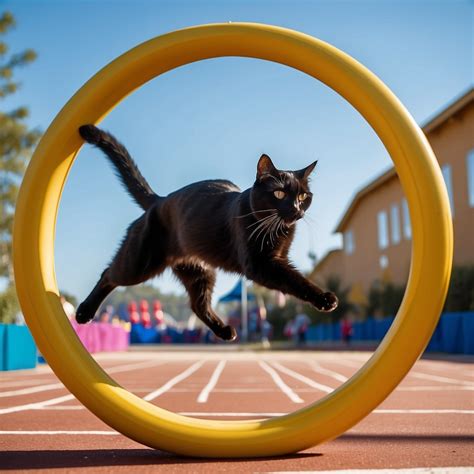Introduction

Cats, known for their innate grace and agility, are increasingly drawn to the exhilarating world of obstacle courses and agility training. These activities not only provide mental and physical stimulation, but also strengthen the bond between cat and owner, fostering a sense of camaraderie and accomplishment. This article delves into the fascinating realm of cat agility and obstacle courses, exploring their benefits, guiding readers through the setup process, and showcasing innovative ideas for feline fitness.
The Allure of Cat Agility
Physical Benefits:
- Improved fitness: Agility courses challenge cats to jump, climb, crawl, and balance, enhancing their overall fitness levels.
- Increased cardiovascular health: Exercise on agility courses raises cats’ heart rates and improves their endurance.
- Reduced obesity: Engaging in agility activities helps cats maintain a healthy weight, reducing the risk of obesity-related health problems.
Mental Benefits:
- Cognitive stimulation: Problem-solving and decision-making are essential for agility courses, stimulating cats’ minds and keeping them mentally sharp.
- Stress reduction: Exercise has been shown to reduce stress levels in cats, making agility courses an excellent outlet for feline relaxation.
- Increased confidence: Successfully navigating obstacles boosts cats’ confidence, encouraging them to explore new challenges.
Obstacle Course Design and Setup
Types of Obstacles:
Agility courses for cats can include a variety of obstacles, such as:
- Tunnels
- Jumps
- Ramps
- Balance beams
- Poles
- Hurdles
Setup Guidelines:
- Start and end points: Designate clear starting and ending points to guide cats through the course.
- Obstacle spacing: Adjust obstacle heights and distances based on the cat’s size and abilities, starting with low obstacles and gradually increasing difficulty.
- Safety measures: Ensure the course is safe for cats by covering corners, providing non-slip surfaces, and using soft landing zones.
Training and Practice:
- Start with basics: Begin with simple obstacles and gradually introduce more challenging ones as the cat gains confidence.
- Positive reinforcement: Use treats or verbal praise to reward the cat for successful completion of obstacles.
- Patience and repetition: Training takes time and patience. Repeat exercises regularly to improve the cat’s skills.
Innovative Ideas for Feline Fitness
- Interactive Cat Mazes: Design maze-like structures that encourage cats to explore and navigate through different paths.
- Climbing Walls: Provide vertical surfaces with climbing holds to challenge cats’ agility and coordination.
- Catnip Obstacle Courses: Engage cats’ senses by sprinkling catnip on obstacles, making the training process more enjoyable.
- Agility Competitions: Organize agility competitions for cats and owners, fostering a sense of community and friendly competition.
Future Trends and Market Insights
Emerging Technologies:
- Wearable fitness trackers: Monitor cats’ activity levels and progress on agility courses.
- Virtual reality agility simulations: Provide interactive training experiences for cats in the comfort of their own homes.
Growing Market:
- According to the American Pet Products Association (APPA), the pet industry in the United States alone is projected to reach $109.6 billion by 2025.
- A significant portion of this growth is attributed to the increasing popularity of cat agility and obstacle courses.
Conclusion
Cat agility and obstacle courses provide a myriad of benefits, including physical and mental stimulation, improved feline fitness, and strengthened owner-pet bonds. By understanding the allure of cat agility, designing and setting up obstacle courses, and embracing innovative ideas, cat owners can create an enriching and engaging environment for their furry companions. With the growing market and emerging technologies, the future of cat agility holds endless possibilities for feline fitness and play.





















